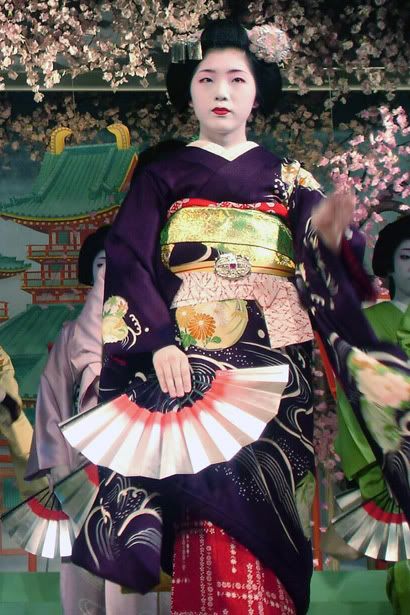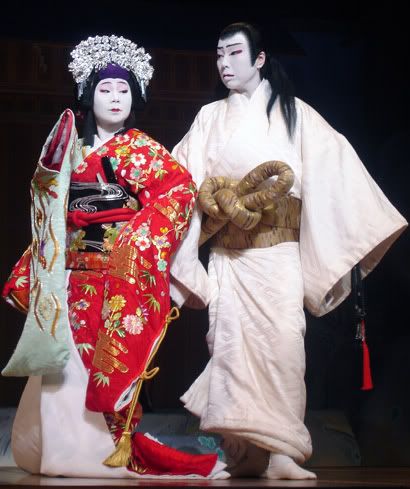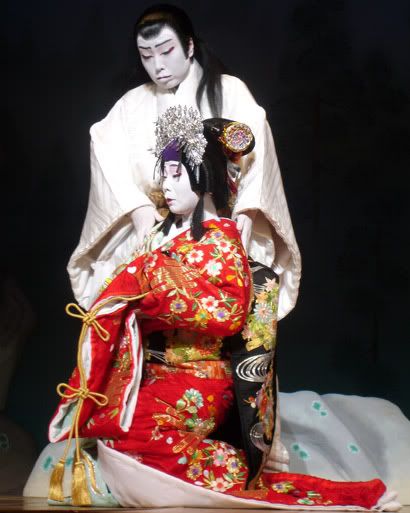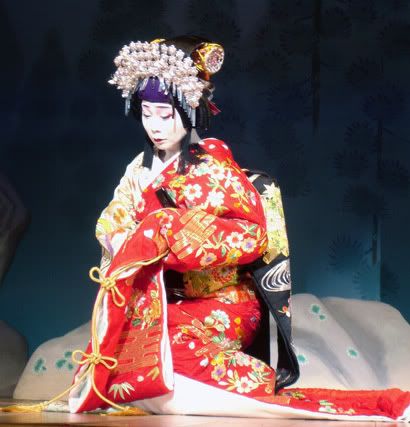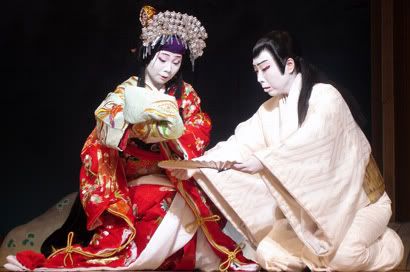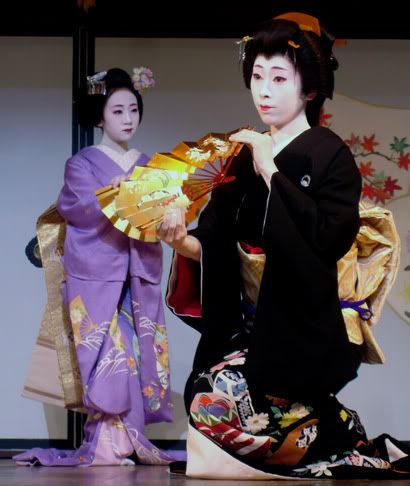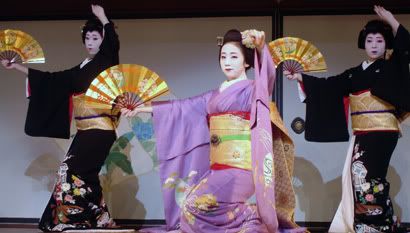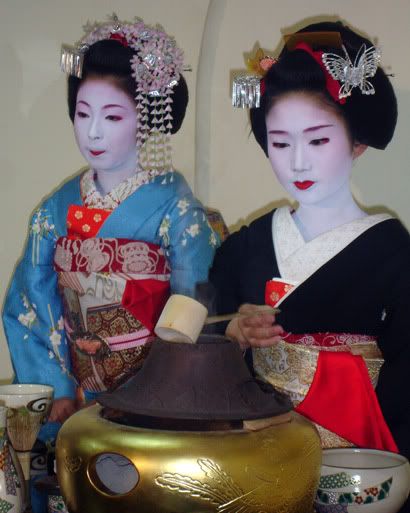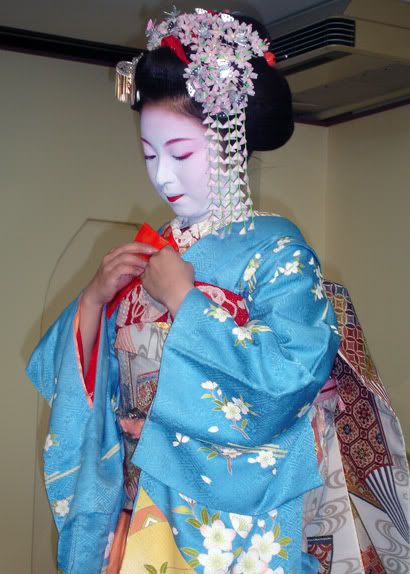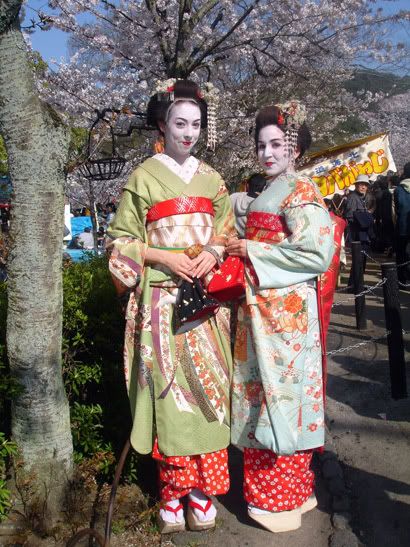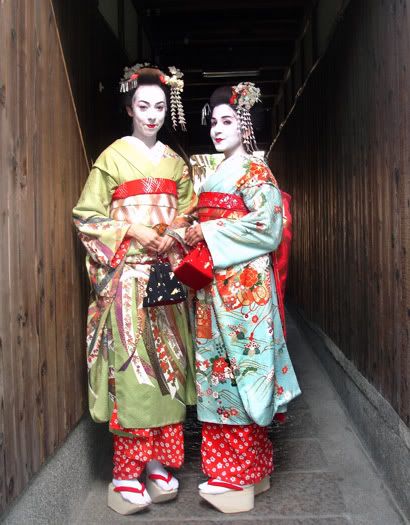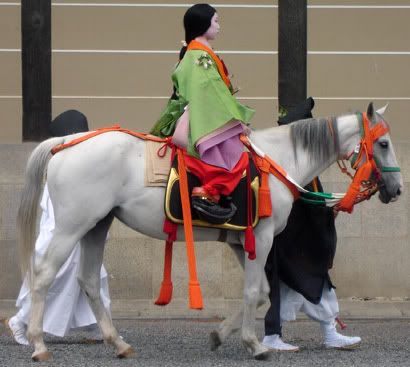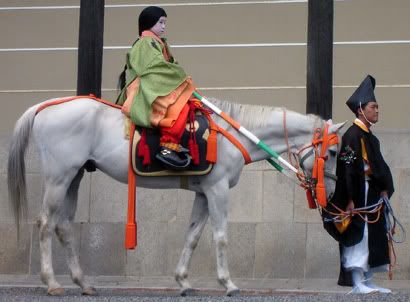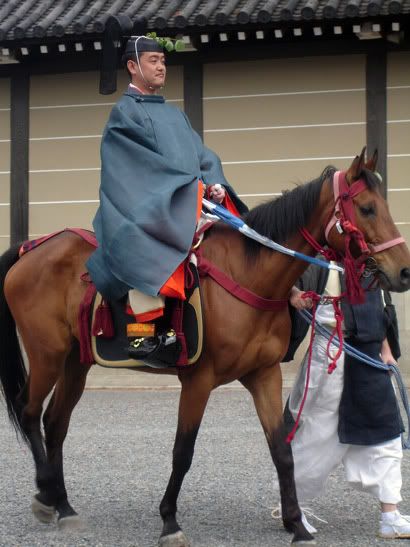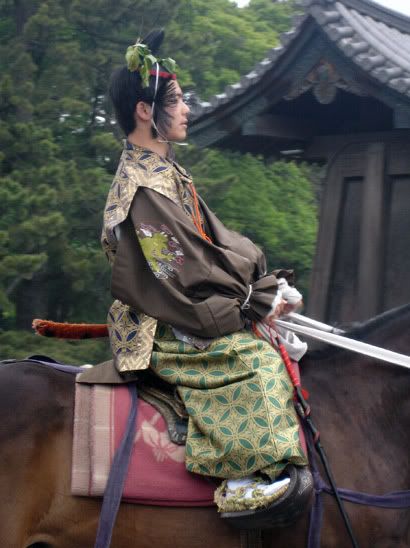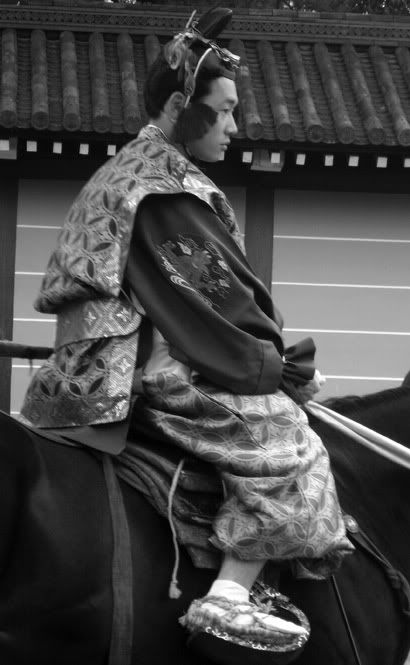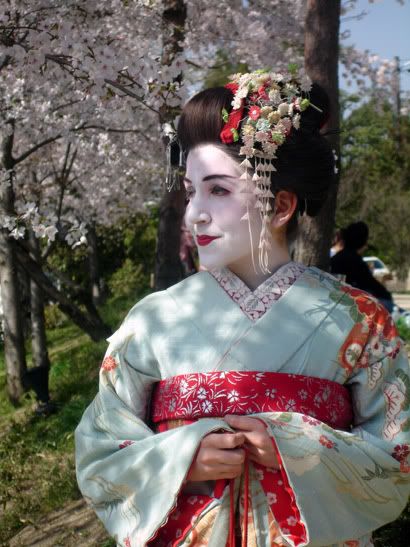
Play of light. Kyoto, April 9th.
As sakura season got into full swing, I decided if I was going to do hanami (literally flowering viewing, in reference to the Japanese passtime of looking at flowers, while drinking sake ofcourse!), I had better do it right! My friend LINZ got me tickets to see sumo for my birthday, so I hopped on the Shink and headed for Kansai, my home away from home. Osaka is only 2 stops from Nagoya, but the first stop is Kyoto, which means I never take the train directly to O-town. I envisioned myself alighting in Kyoto and strolling beneath the shade of the sakura canopy long before ever reaching Osaka, so I texted Lindz, who was due to work for the evil spawn of Satan that is NOVA. Needless to say, after a little peer pressuring, I persuaded her to call in sick at meet me for a springtime sakura extravaganza!
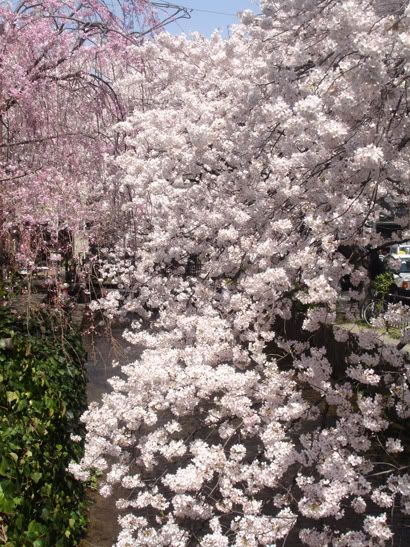
The morning was rich with the promise of spring, sunny and warm. Warm? I mean I was hot! I couldn't remember the last time I felt warm without 5 layers of clothes on! It was a vast diffference from the winter chill that still hung in the air beneath the snow-capped summit of Mt. Ena. Although Lindz and I have been Japanified for sometime now (we met while studying abroad at Kansai Gaidai), neither of us had ever experienced sakura.

I don't think I can articualte the feeling I got when I walked down a street near a small river, lined with cherry trees in full bloom. It was so beautiful, it didn't seem real. The sakura blossoms diffused the gems of sunight that gathered in tiny droplets on their petals, creating a soft white glow that transformed everything into an magical dreamscape. It was as if delicate clouds of sweet smelling flowers had floated down to earth from a heavenly garden and were captured by the trees, whose branches reached up to heaven to catch them as they dance in the breeze. Rivers of light flowed through the loosely woven lace of flowers, cutting through the soft white mist, and the splatters of light that dripped through the blossoms formed flower-shaped puddles of sunlight on the ground beneath.
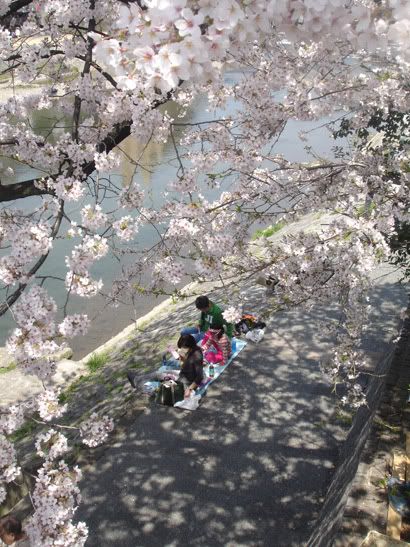
A family enjoys a picinic on the bank of the Kamo River.
As we walked through Gion with the myriads of flower-happy tourists, were inspired to take full advantage of the season by dressing up like maiko, venuturing around the photogenic Higashiyama district and taking pictures of the sakura. Lindz, who is an old pro at this Maiko wannabe thing, had Studio Shiki's number in her Ketai (cell phone). We figured they'd be booked, but Suprisingly they were free at 1 PM, which gave us just enough time to wind our way up towards Kiyomizudera, taking a slight detour through Maruyama Koen. Luckily I know the way by heart!

As we began the transformation from Gaijin to Geisha-in-training, I watched in a brightly lit mirror as my face disappeared behind a thin veneer of Oshiroi, white makeup. The artist used an array of brushes of all shapes and sizes to spread the snowly linen canvas smoothly across my face, and then began to brush highlights of pinks and reds around my eyes, dipping her brush in a bright crimson before carefully drawing in my lips, like rose petals curled on the surface of freshly fallen snow. I wore a thin linen robe with a deep neck line that hung low from my shoulders, exposing my neck, shoulders and back. She dipped a large, cresent shaped brush in the Oshiroi before I felt the cool, wet hairs slide down my back, sending shivers down my spine. I wondered how any woman would have the patience to go through this ritual every day, but it felt invigorating to be transformed so vivdly.The application of the makeup alone had awakened every one of my senses.
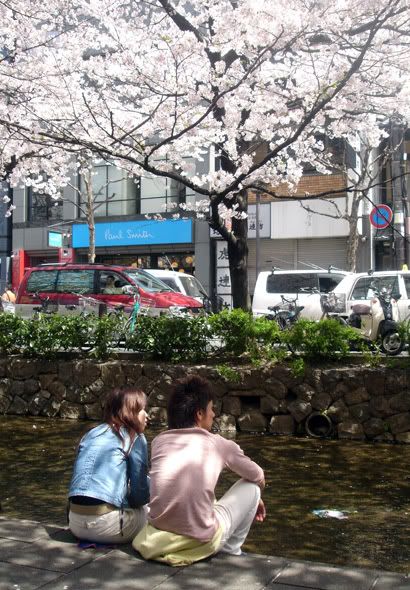
When she was finished we were sent off to choose kimonos, though they were so busy there were very few to choose from. Teams of women wrapped us in layers of fabric as we stood side by side, hypnotized by our own image in the mirror as we fought to keep our balance. When we had survived the worst, the women secured our katsura, or maiko style wigs, tightly in place (or so it seemed), and rushed us into a tiny studio for a few professional photos. As I struck each pose a chorus of "kawaii!" rose up from the trio of Japanese maiko-wannabes next in line. When the shoot was over, we fled the crowded studio, slowly sliding into the only peice of our wardrobe that had not been wrapped around us and tied into place- the Pokkuri. Pokkuri are thick, platformed, wooden clog sandals that make walking a hazard to one's health. After gingerly desending the three steps outside the studios door (it seemed more like 30) we slowly scuttled down the alleyway towards the corner. Our debut on the main thoroughfare of tourists enroute to Kiyomizudera did not go unnoticed. From a distance I could hear people point us out, comment on how cute or beautiful we looked, and then become quite shocked when they realized we were gaijin! We were like rockstars! We couldnt take 5 steps without being asked to take a picture, which was until we realized we werent taking any of our own!
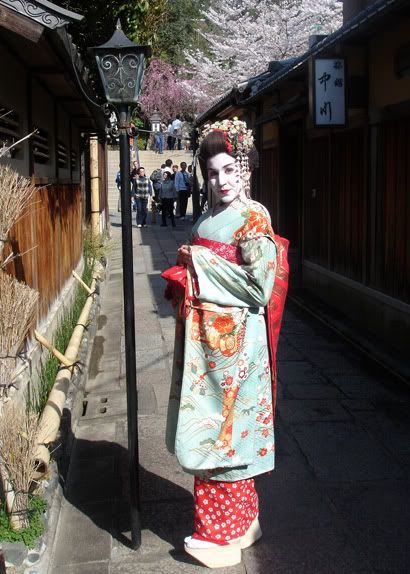
I think I was actually posing for someone who had asked to take my picture. Yeah, thats my excuse for being the biggest dork of all time.

Slowly we made our way towards Maruyama Koen, the most famous hanami spot in Kyoto. On the way, a Japanese boy dressed up in kimono with his girlfriend, stopped to watch as Lindz took my picutre beneath a sakura tree. Finally he worked up the courage to ask if he could have his picture taken with me. How could I say no? He was wearing kimono! "Beautiful!" he said as he bowed to me "Meccha kirei!"
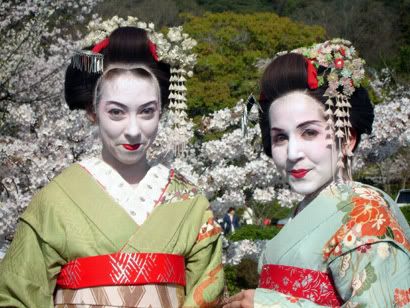
We hiked all the way to Maruyama Koen, famous for its cherry blossoms and Hanami parties.
The park was packed. In Japan, any reason to drink is a good one, and they really like looking at trees. In the fall, its the changing leaves, and in the spring, its sakura. So what better way to celebrate than to camp out under a sakura tree and get drank? I will say one thing for them...Their fortitude is amazing. They get up at 7 AM, go to wherever the cherry trees are and set out a tarp. Then they start eating and drinking. By noon everyone is passed out under the cherry trees, but before the clock strikes 2 they regain consciouness and commence drinking again! So much fun, and no one ver fights or starts trouble. Gotta love Japan!
Blue skies, cherry blossoms, wannabe maiko and squid on a stick! Nothing beats Maruyama Koen in the spring!
Alas, nothing gold can stay. The heat of the spring sun, combined with the 10 extra pound of silk we were burried under as we hiked across Kyoto, was taking its toll. The Katsura wigs we thought were tightly in place could not take the pace of our race to the park. Lindz`s wig began to slide back past her hairline, so every few steps we would casually disappear into the nook of an old, forgotten shrine as i tried to slide it back into place. Mine began its treachorus decent as well, as we hurried like Cinderella to make it back to the studio before we turned into pumpkins. By this time I felt like an old pro in my Pokkuri, speeding right along as we were being admired by a few tourists who I had heard comment on how well were waking in the medieval tourture devices. Thats when Lindz turned her head to say something and saw me float like a petal in the wind, down to the cobblestone road, where I began to burst out laughing. I was back up on my feet and fleeing the scene at an even quicker pace than before as Lindz, good friend that she is, tried to convince me that atleast I hadden fallen gracefully. We spent the rest of the time composing Haiku about ourselves as maiko, and about the fall.
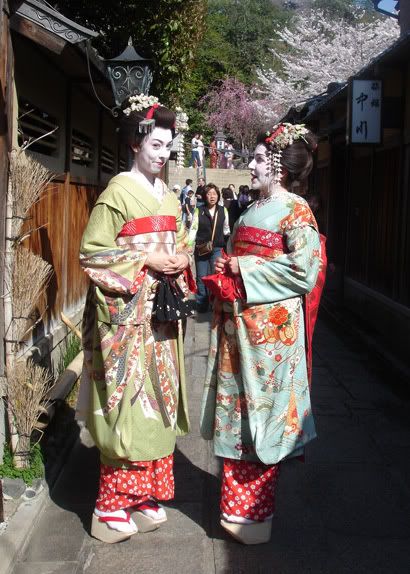
Stopping for a chat in Nene No Michi.
We also composed a scheme to get more time in the limelight. Since Lindz wig really had come undone, I figured she should just let it come off, walk in holding it and ask that they secure it again so we could go out and take pictures. Though it was a less than nobel effort, we were out of luck. It was still an awesome adventure, and I can't think of anyone I would rather do it with than Takahana hereself!
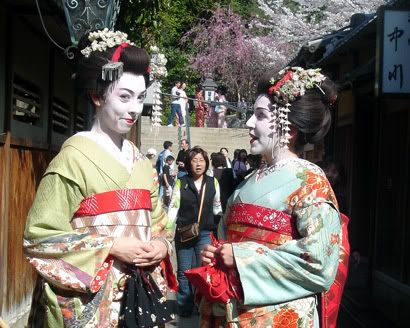
Lindz could so be Japanese!
A famous alleyway in Kyoto.
